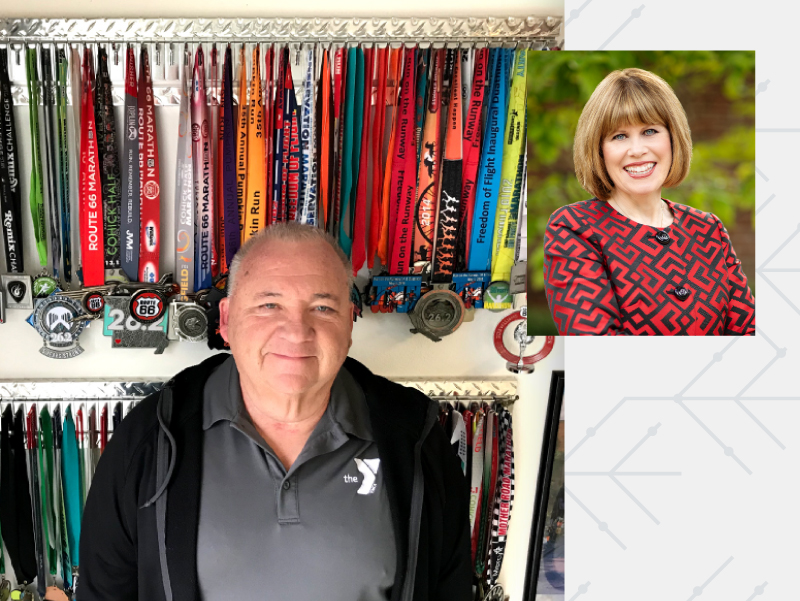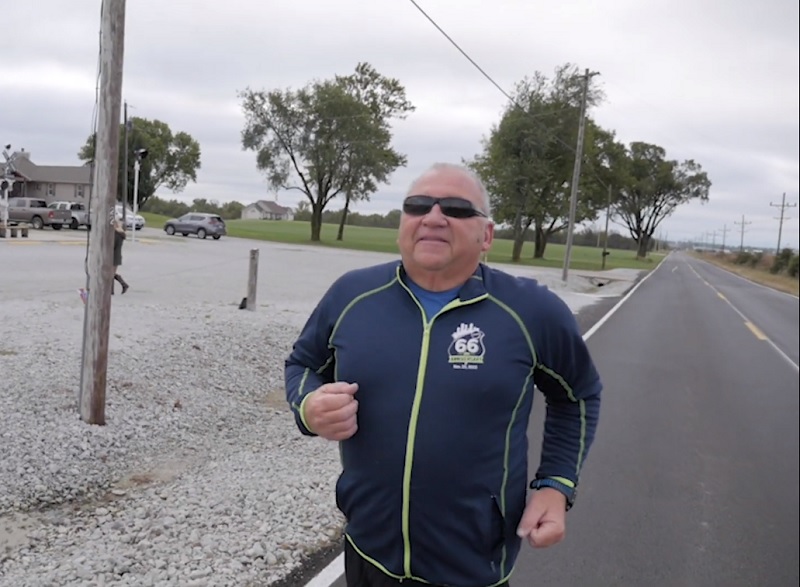Over 300 pounds, he started getting in shape. Not even a triple bypass slowed him.
By Nancy Brown, American Heart Association CEO

Because his parents owned the Hertz franchise at the airport in Joplin, Missouri, Bobby Ballard figured he would eventually work there. At 24, though, he wanted to do something else.
He took a job with Frontier Airlines. As the youngest employee by several decades, colleagues kept him moving – cleaning planes, selling tickets, overseeing boarding and anything else that had to be done. He also received uniform pants with a 34-inch waist.
"We haven't had anyone wear one that small in years," the boss said.
Bobby ended up taking over his family business. He became less active and more stressed. He gorged on fried foods for most lunches and settled for fast food too often for dinner. That left him buying pants in larger and larger sizes as his weight went from 190 pounds to the mid-200s to beyond 300.
"I knew that was not a healthy place to be," he said. "I just didn't care enough to do something about it. Then I woke up one day and decided it was time to make a change."
Since this story is meant to inspire and encourage anyone aiming to fulfill a New Year's resolution centered on health and fitness, now is a great time to mention that the hero of this story gets into shape, runs a marathon and now helps train other runners.
But the arc of the story isn't that smooth. It's interrupted by a reminder of what can happen to people who neglect their health until it's (almost) too late.
***
It was January 2010 when Bobby decided enough was enough. He was carrying way too much weight for his 5-foot-9 frame.
Walking seemed like a simple way to get moving. The weather was too miserable to be outdoors, so Bobby headed inside Northpark Mall, where he'd seen others walking briskly. His maiden voyage was interrupted by frequent stops to catch his breath.
With his affable personality, Bobby befriended some fellow mall-walkers. Within a few months, "I could easily walk 4, 5, even 6 miles at a brisk pace."
As he got into shape, he took a close look at his diet.
A lifelong foe of vegetables, Bobby joked that he "didn't know what a salad was." Soon enough, his lunch order went from the fried special of the day to a salad. If he ordered chicken, he requested it grilled. He swapped fries for fruit plates.
"I got to the point where I enjoyed that," he said. "And the weight really started to come off. I was down to probably 210-220. It was quite rewarding to purchase clothes again not in the tall-and-big man section."
He even bought his first pair of shorts in more than 20 years.
***
Once the weather improved, Bobby began walking outdoors. He noticed groups of runners passing him.
He also noticed they were laughing and having fun.
In late 2010, Bobby went to the Joplin Family Y and signed up for an Anyone Can Run class, a program that helps turn non-runners into finish line crossers. He also signed up to run the Armed Forces 5K in May 2011.
To be safe, Bobby went for a physical. The doctor was pleased. The only medicine Bobby needed was to help control his blood pressure.
On a hot evening in mid-April, his training group met at a park in the center of town for a 3-mile run. (A 5K is 3.1 miles.) After, Bobby grabbed a jug of water from his car and joined his friends sitting under a tree. They savored the shade and joked about what great runners they were.
"And that's the last thing I remember for eight days," he said.
***
Bobby's heart stopped. A blockage caused a heart attack, which in turn caused cardiac arrest.
He slumped to the ground, making a snoring sound. Some thought their jovial buddy was being silly. But one member of the group – a woman who'd been a nurse for 25 years – realized he was gasping for air.
Beyond the obvious good fortune of her being among them, there's more to it. The week before, she'd renewed her CPR training. For several weeks, conflicts kept her from attending the Anyone Can Run sessions; that day she'd vowed that nothing would keep her away.
The nurse (who prefers remaining unnamed) started CPR while others called 911. Paramedics arrived quickly and used a defibrillator to restore a heartbeat. He got a total of seven jolts by the time he reached the emergency room.
***
The largest coronary artery – the one that supplies blood to most of Bobby's heart – was 98% blocked. A heart attack caused by a blockage in that artery is dubbed a "widow maker" because of how often it ends lives.
A doctor in the ER told Bobby's wife, Jane, to expect him to be another victim. With two other arteries also more than 90% blocked, the doctor didn't think Bobby would survive the night.
Bobby's cardiologist suggested inserting stents to open the blockages. It was risky for many reasons. Then again, not trying was risky too. Jane consented.
A week later – following the insertion of three stents, then a triple bypass operation – doctors brought Bobby out of the coma.
***
Once Bobby grasped his situation, he thought, "I've done all this work to get in shape and this still happened."
Then he thought, "This is a residual effect of my bad lifestyle and not taking care of myself."
In other words, he recognized that 17 months of fitness wasn't enough to erase his previous 50 years.
Yet he soon discovered that those 17 months helped with what came next.
On the day he regained consciousness, Bobby went from standing to walking the hallway to asking nurses what he needed to do to go home. They said he had to go down two flights of stairs and back up on his own. Two days later, he did.
While getting discharge orders from his doctor, Bobby asked when he could return to running or walking. Because of the invasiveness of the bypass operation, running would have to wait several months.
"But I want you to walk as much as you can," the doctor said.
Five weeks later, Bobby walked the Armed Forces 5K.
His class of fellow beginners crossed the finish line wearing shirts that read "Running for Bobby."
Then they returned to the route to walk across the line with him.
***
Once Bobby was cleared to run, "I went crazy with it," he said, laughing.
In May 2012, a year after his near-fatal cardiac events, he ran a half marathon.

In April 2013, he ran the Garmin Marathon in Olathe, Kansas. Each year, finishers receive medals based on "Wizard of Oz" themes. That year's design happened to feature the Tin Man, the character who receives a heart.
When Bobby was within a mile of the finish, the announcer told the crowd his story. A raucous ovation carried him the final 100 yards or so.
"People I didn't know came out of the crowd hugging and kissing me," he said, laughing again. No wonder he still calls it his favorite marathon.
Bobby has done eight marathons, the last in October 2018. He's likely done running 26.2 miles at a time, but still enjoys half marathons and shorter events. His next 13.1-miler is in May.
Bobby also has run races as a pacer, a way of helping others achieve their time goals. For instance, he'll vow to finish a marathon in six hours and anyone who keeps up with him will do so, too.
That selfless act is pretty much his theme these days.
Having sold the Hertz franchise and retired three years ago, he now works at the Joplin Family Y as a wellness coach and as a running coach, as certified by the Road Runners Club of America. Among his duties: leading an Anyone Can Run class.
A few years ago, he signed up for his local Heart Walk, benefiting my organization, the American Heart Association. He also supports our mission by speaking about everything from heart health to the importance of learning Hands-Only CPR, which has only two rules: if you see an adult collapse, call 911 and then push hard and fast in the center of their chest.
Bobby reached the 2020s much healthier than he did the 2010s. Now he hopes others can follow his lead to the starting line of their own decade of improved heart health.
A version of this story also appeared on Thrive Global.
If you have questions or comments about this story, please email [email protected].





